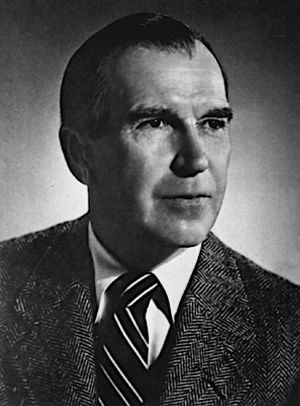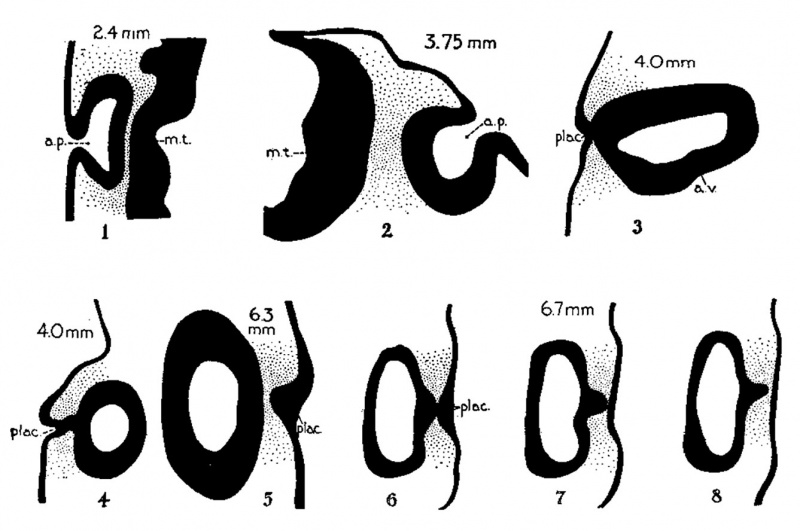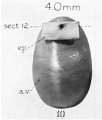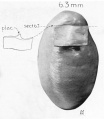Paper - The early relation of the auditory vesicle to the ectoderm in human embryos

| Embryology - 28 Apr 2024 |
|---|
| Google Translate - select your language from the list shown below (this will open a new external page) |
|
العربية | català | 中文 | 中國傳統的 | français | Deutsche | עִברִית | हिंदी | bahasa Indonesia | italiano | 日本語 | 한국어 | မြန်မာ | Pilipino | Polskie | português | ਪੰਜਾਬੀ ਦੇ | Română | русский | Español | Swahili | Svensk | ไทย | Türkçe | اردو | ייִדיש | Tiếng Việt These external translations are automated and may not be accurate. (More? About Translations) |
Anson BJ. and Black WT. The early relation of the auditory vesicle to the ectoderm in human embryos. (1934) Anat. Rec. 58: 127-137.
| Historic Disclaimer - information about historic embryology pages |
|---|
| Pages where the terms "Historic" (textbooks, papers, people, recommendations) appear on this site, and sections within pages where this disclaimer appears, indicate that the content and scientific understanding are specific to the time of publication. This means that while some scientific descriptions are still accurate, the terminology and interpretation of the developmental mechanisms reflect the understanding at the time of original publication and those of the preceding periods, these terms, interpretations and recommendations may not reflect our current scientific understanding. (More? Embryology History | Historic Embryology Papers) |
The Early Relation Of The Auditory Vesicle To The Ectoderm In Human Embryos
Barry J. Anson And William T. Black, Jr.
Department Of Anatomy, Northwestern University Medical School, Chicago
Eight Text Figures And Two Plates (Eleven Figures)
- Contribution no. 191 from the Anatomical Laboratory of Northwestern University Medical School. This study constitutes a subsidiary phase of an investigation conducted under the auspiccs of the American Otological Society. Paper read at the New York City meetings of the American Association of Anatomists, February, 1932; abstract, Anatomical Record, vol. 52, no. 1,pp. 2-3, February 25, 1932.
Perhaps no single feature of mammalian organogenesis is better known or more frequently observed in laboratory courses in embryology than the early development of the membranous labyrinth ; detailed accounts are available descriptive of the stages through which the organ passes to assume the form, successively, of placodal thickening, invaginated pit, detached sac, and bilobed vesicle with diverticular processes. The exact manner, however, in which the auditory vesicle first becomes a separate structure is not well understood. It is with this phase in the development of the human ear that the present study is specially concerned.
Material And Methods
This investigation was carried out principally upon the series of early human embryos in the Harvard Embryological Collection ; additional observations were made upon comparable stagesinthe Department of Embryology of the Carnegie Institution.[1] We were particularly concerned with the stages between 2.4mm. and 12mm., and with only two representative advanced stages, the 29- and the 40-mm. Of the stages from 2.4 to 12 mm., twenty-seven series in the Harvard Collection were studied; of those between 3.0 and 6.6 mm., forty-four series in the Carnegie Collection. The series in the Harvard Collection which best displayed the changing relation of the otocyst to the ectoderm were selected for modeling by the Born wax-plate method; these models, shown in plates 1 and 2, were prepared from the following embryological series: 2.4, 4, 6.3, 8, 12, 29, and 40 mm.
Observations And Discussion
In our models of favorable series in the Harvard Collection it is possible to follow the stages in the disappearance in the original stalk of connection between the auditory vesicle and the outer ectoderm.
In the embryo of 2.4mm. (figs.1and 9) the thickened area of ectoderm, the auditory placode, has become invaginated to produce a pit widely open to the exterior. In an embryo of 3.75 mm. (fig. 2) the auditor sac is still patent.[2] At 4 mm. (figs. 4 and lo), although the orifice has become closed by the the growing together of its margins,[3] the solid stalk remains and holds the vesicle in temporary union with the outer ectoderm; in the two 4-mm. embryos of Keibel and Elze ( '08, figs. 9c and llc-d) the connection is likewise still unruptured. Growth of the vesicle has principally affected its length, so that the stalk is now near the dorsal limit of the lateral aspect. In another series of the 4-mm. stage (fig. 3) the stalk of communication has broken[4] but the outer ectoderm and the adjacent wall of the vesicle are still in intimate contact (compare figs.4and 3); in the embryos 5.3 mm. and 5 to 6 mm. in length described by Keibel and Elze (table, p. 100; figs. 13 a-b)</ref>, the vesicle is detached, but its relation to the ectoderm is also one of contiguity. The shape of the vesicle itself in our model is very similar to that in the 4.3-mm. stage modeled by Streeter ('06-'07, fig. a, pl. 1). In our 6.3-mm. embryo (figs.5 and Il),the placodal stalk remains, although not as a continuous structure, but merely as a limited thickening opposite the dorsal sixth of the now piriform vesicle. The latter, now freed, shows the first indication (fig. 12, at arrow) of the constriction which will delimit the endolymphatic appendage. The otocyst, considerably enlarged over the 4-mm. stage, continues to undergo general expansion, and, particularly to lengthen ventralward (fig. 14); concurrently, the shallow depressed area, just apparent in the 6.3-mm. stage (fig. 12), becomes a pronounced crease at 6.7 mm. (fig. 13, at arrow) ; it definitely marks off the endolymphatic appendage from the vestibular portion of the vesicle. The development of this crease is due to inpushing of the vesicle's wall, as is proved by the observation that the vesicle, at the root of the growing appendage, is narrower in the 6.7-mm. and 8-mm. embryos than it is in the one of 6.3 mm. (compare figs. 13 and 16 with fig. 12).
Abbreviations For All Figures
a.p., auditory pit a.v., auditory vesicle (otocyst) c.d., cochlear duct coch., cochlear part of vesicle e.ap., endolymphatic appendage e.d., endolymphatic duct e.pr., eiidolymphatic projeetion e.s., endolymphatic sac ep., epidermis l.s.d., lateral semicircular duct m.t., medullary tube plac., placodal stalk sacc., saccule s.s.d., superior semicircular duct utr., utricle vest., vesibular part of vesicle
Figs. 1 to 8 Auditory region. Transverse sections of embryos in the Harvard Embryological Collection. Dorsal aspect downward (except in 3 ) . x80. 1, 2.4 mm. (CR), H.E.C. (loan) sectioii 28. Auditory pit (see level in model, figure 9. 2, 3.75 mm., H.E.C. 2085, section 159. Auditory pit. 3, 4 mm., 714, section 11. Auditory vesicle in contact with the epidermis. 4, 4 mm., 2302, section 12. Auditory vesicle collected with the ectoderm by a solid placodal stalk (see level in model, fig. 10). 5, 6.3 mm., 2300, section 67. Placodal stalk now ruptured (see level on fig. 11). 6, 7, 8, 6.7 mm., 2285, sections 71, 72, 73, respectively. Remnants of placodal stalk of attachment persist 011 both the endolymphatic appendage and the epidermis (see level, section 72, in models, figs. 13 and 14).
On the lateral aspect of the appendage, at the junction of its distal and middle thirds, a nodular projection persists, which is the remnant of the original stalk of connection. This low protuberance extends through eight sections (of 81-1 each), while the corresponding thickening on the adjacent ectoderm is limited in its extent to 1 section (fig. 6)-aiid does not appear above or below (figs. 7 and 8) this level. A corresponding remnant persists on the ectoderm, just oppo- site the nodule on the appendage; at this stage, then, the two vestiges of the stalk of origin have not yet moved away from each other. The nodular vestige on the appendage neither appears in comparable stages pictured by Streeter[5] ('06-'07, fig.b, pl.1),and His, Jr. (1889,Taf. I, fig.3),nor is mentioned in the tables of Keibel and Else ( '08) descriptive of comparable stages in which the endolymphatic duct is clearly distinguishable; it is pictured by Perovic and Aust ( ’15, figs. 1, 2, Taf.44) as holding a more distal position. The fortunate per- sistence, in the series studied, of the two definite, though transitory, remnants of the placodal stalk permits one to render more precise the statement by Keibel (Keibel and Mall, ’12, p. 266) to the effect that the recessus labyrinthi (later, ductus and saccus endolymphaticus) “arises in man in immediate relation with the point of closure of the auditory vesicle . . . .”; it may be said, rather, that the point of closure is represented (in the 6.7-mm. embryo) by a nodule-like remnant situated on the lateral aspect of the endolymphatic appendage at the junction of its distal and middle thirds; moreover it may be said that the preponderant growth of the vesicle is ventralward while the two remnants of the primitive stalk of origin - of vesicle and of epidermis - still remain apposed.
In the 8-mm. embryo (figs. 15 and 16) the prominences on the vesicle and the epidermis are no longer present, both epithelial surfaces being quite smooth. The endolymphatic appendage has concurrently increased in length and in width by one-half, and has become lance-shaped. The vestibular portion of the vesicle gradually undergoes enlargement and bulges prominently lateralward ; the protrusion removes the endolymphatic appendage from a dorsal to a medial position (Keibel and Mall, ’12, p. 266; Perovic and Aust, ’15); the removal of the appendage from a situation just subjacent to the epidermis to a deeper position, together with the disappearance of the placodal stalk, render it impossible to trace any further relation between the freed vesicle and the site of original ectodermal attachment.
The delimiting crease seen in the several early stages (figs. 12, 13, and 16, at the arrows) becomes in the otocyst of the 12-mm. embryo (fig. 17) a marked invagination which now further sets off the elongated endolymphatic appendage from the vestibular part of the otocyst. The later now consists of utricle and saccule; from the utricle are given off the diverticular semicircular ducts, from the saccule arises the cochlea. The ledge of tissue which forms the crease (fig. 17, a t arrow; also fig. 13) between the endolymphatic duct and the common point of origin of the superior and lateral semicircular ducts, is the utriculo-endolymphatic fold or 'valve' described by Bast ( '28), Wilson and Anson ( '29), and others.[6]
The endolymphatic appendage in the embryo of 12 mm. is divided into the proximally placed ductus and the distal expansion or saccus. In older embryos (figs. 18 and 19) the sac becomes expanded and flattened medio-laterally ; its free extremity is no longer merely pointed, but is prolonged dorsalward as a thread-like projection (figs. 18 and 19), the occurrence of which has been recorded by Tandler (in Keibel and Elze, '08, tables 55 and 65) and by Macklin ('21)' and its development in man described by Anson ('33). This distal projection does not arise at the point of closure of the vesicle, and therefore cannot be homologous with the elongate patent extremity of the sac in the shark (Scammon, '11, figs. 12, 13, 15,16, of embryos 11.5,15,18, and 20.6 mm. in length; Quiring, '30, fig. 21, pl. 3).
Text Footnotes
- ↑ The tracings were made, at the two institutions, by the senior author; the junior author prepared the wax models.
- ↑ In the Cariiegie series, the structure is still a pit in four 3-mm. embryos (1182b, 4497, 6050, aud 239) and in two 3.4-mm. embryos (5056 and 6097).
- ↑ In the Carnegie series of a 3.9-mm. embryo (463) it is also closed but free from the ectoderm, as it also is in all the older stages examined, except one of 4mm. (486) and one of 4.5 mm. (1062) in which the lips are in virtual contact.
- ↑ The ruptured stalk is still present as a projection of both vesicle aud epidermis in one 4-mm. series (no. 963) in the Carnegie Collection; in three additional 4-mm. series (836, 808, 4784) it is present on the epidermis only; in four more advanced series, of 4.85, 5, 5.5, and 6 mm. (2841, 5654, 1380, 5541 respectively), there is a slight thickening of the ectoderm; thickenings are wanting in the following series: 4.6 mm. (588) ; 4.3 mm. (148) ; 4.5 mm. (76) ; two of 5 mm. (523, 826); one of 5.5 mm. (3960); four of 6 mm. (241, 676, 988, 1075): one of 6.5 mm. (800).
- ↑ 'Since the completion of this paper, the writer has kindly been permitted by Dr. G. L. Streeter to examine the lantern slides of serial sections shown in connection with the latter's paper ('31) read at the Chicago meetings of the American Association of Anatomists; in these series, as Doctor Streeter then pointed out, the vesicle has become detached in 4-mm. embryos, at which stage the stalk may remain as a projection of the epidermis only, or of the vesicle as well. With these observations our own are in agreement (footnote 5).
- ↑ An account of the development of the fold in vertebrate embryos is in preparation by the senior author.
Explanation of Figures
Plate 1
| Auditory vesicle in human embryos Figures 9 to 14. Models prepared from transverse series in the Harvard Embryological Collection. In figures 9, 10, and 11 an arbitrary patch of ectoderm, in the region of the auditory placode, is included in the model. The levels which represent the sections shown in the text figure are indicated by horizontal lines. X 130.
|
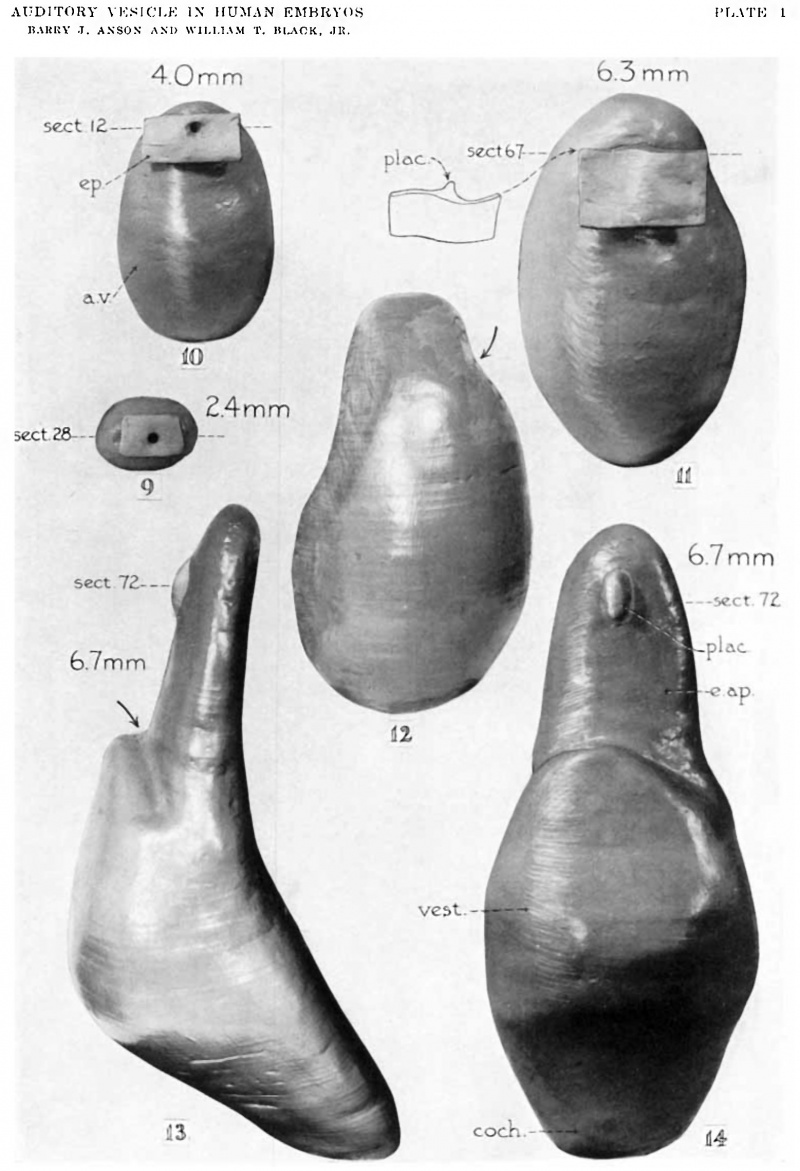
|
Plate 2
| Auditory vesicle and endolymphatic appendage in human embryos Figures 15 and 16, models prepared froiii a transverse series; figures 17, 18, and 19, from frontal series in the Harvard Embryological Collection. Figures 15 and 16, X 130; 17, 18, and 19, X 45.
|

|
Literature Cited
Anson BJ. The distal projection of the endolymphatic sac in human embryos. (1933) Anat. Rec. 701. 57, 110. 1, pp. 55-58.
Bast TH. The utriculo-endolymphatic valve. (1928) Anat. Rec. 40, 110. 1: 61-64.
HIS, W.M., JR. 1889 Zur Entwicklungsgeschichte des Acustico-Facialisgebietes beim Menschen. Arch. f. Anat. u. Physiol. Anat. Abth. Suppl., S. 1-28.
KEIBEL, F., AND C. ELZE 1908 Nomentafel Zur Entwicklungsgeschichte Des Menschen. Jena. (Achtes Heft, of Keibel's Normentafeln zur Entwicklungsgesehichte der Wirbeltiere.)
Keibel F. and Mall FP. Manual of Human Embryology II. (1912) J. B. Lippincott Company, Philadelphia.
Macklin CC. the skull of a human fetus of 43 millimeters greatest length. (1921) Contrib. Embryol., Carnegie Inst. Wash. Publ., 48, 10:59-102.
PEROVID C., AND 0. AUST 1915 Zur Entwickelungsgeschichte des Ductus endolymphaticus beim Menschen. Anat. Hefte, Bd. 52, S. 699-716.
QUIRING, D. P. 1930 The development of the ear of Acanthias vulgaris. J. Morph. and Physiol., vol. 50, 110. 1, pp. 259-293.
SCAMMORN. ,E. 1911 Normal plates of the development of Squalus acanthias. Jeiia. (Zwolftes Heft of Keibel’s Normentafeln.)
Streeter GL. On the development of the membranous labyrinth and the acoustic and facial nerves in the human embryo. (1906) Amer. J Anat. 6:139-165.
- 1931 Early stages in the development of the ear vesicle in the human embryo. Abstract, Anat. Rec., vol. 48, suppl., p. 35.
WILSON, J. G., AND B. J. ANSON 1929 The utriculo-endolymphatic valve (Bast) in a two-year-old child. Anat. Rec., vol. 53, no. 2, pp. 145-153. 
Cite this page: Hill, M.A. (2024, April 28) Embryology Paper - The early relation of the auditory vesicle to the ectoderm in human embryos. Retrieved from https://embryology.med.unsw.edu.au/embryology/index.php/Paper_-_The_early_relation_of_the_auditory_vesicle_to_the_ectoderm_in_human_embryos
- © Dr Mark Hill 2024, UNSW Embryology ISBN: 978 0 7334 2609 4 - UNSW CRICOS Provider Code No. 00098G


